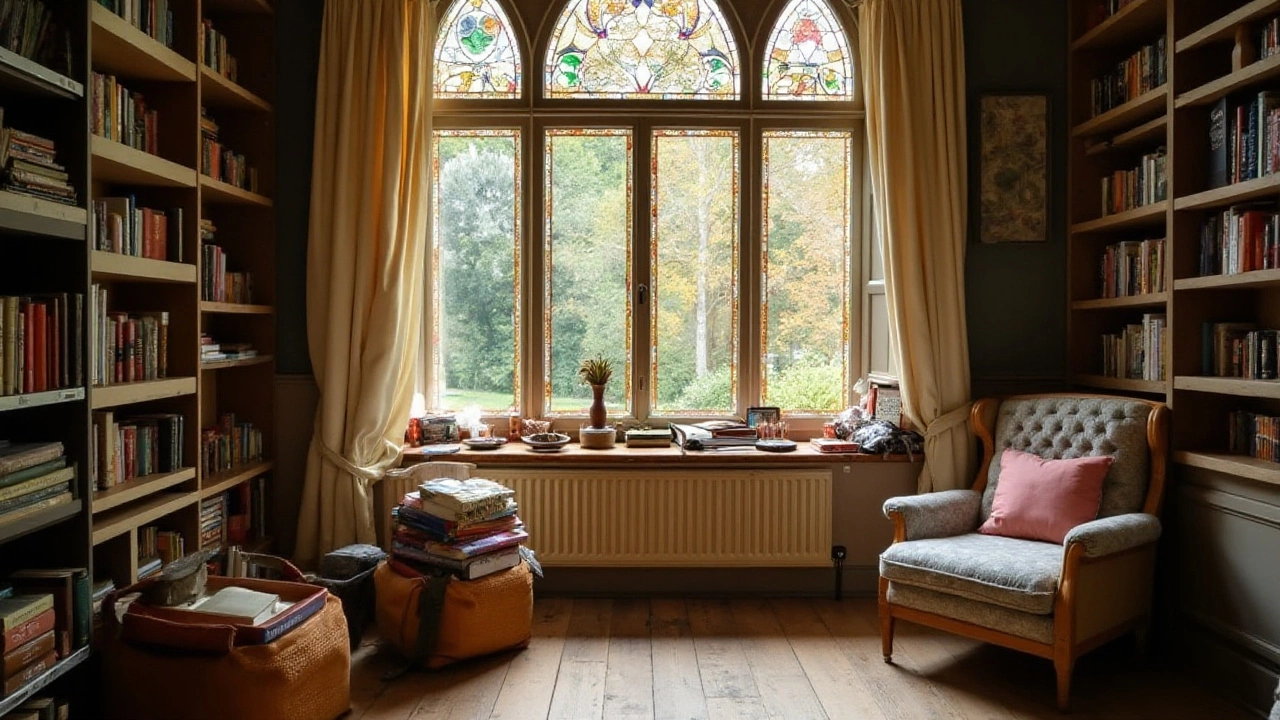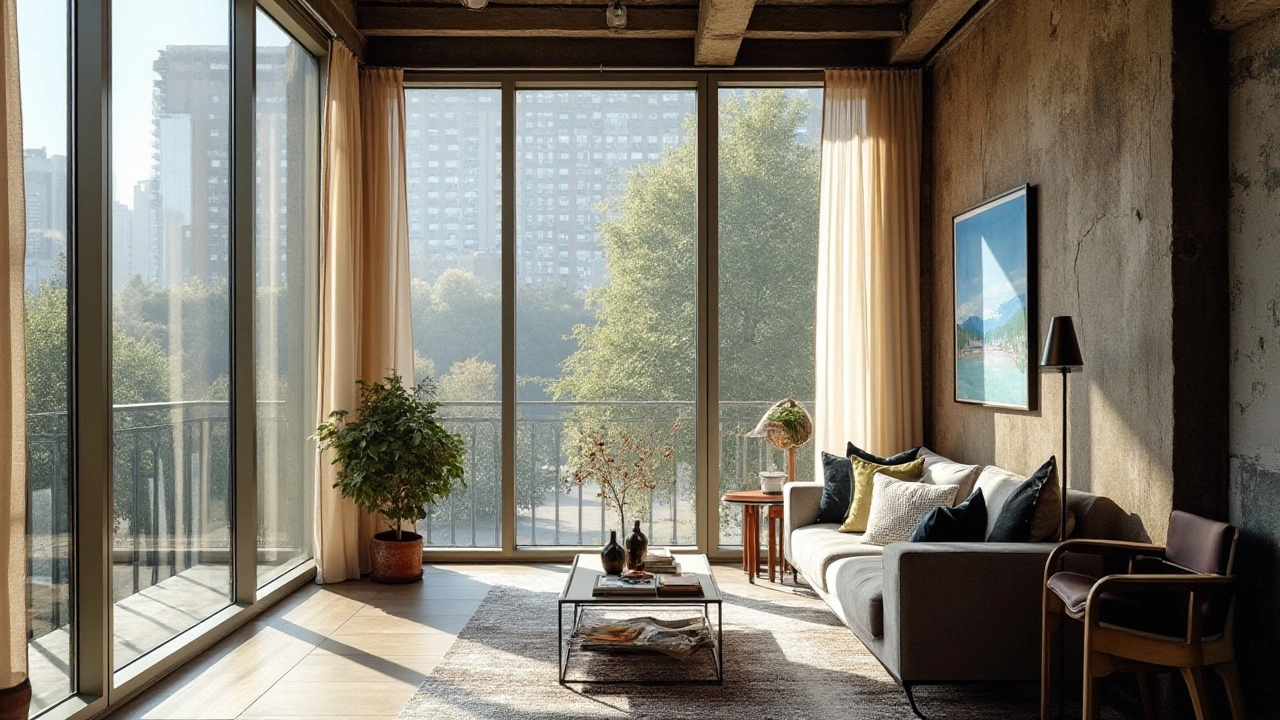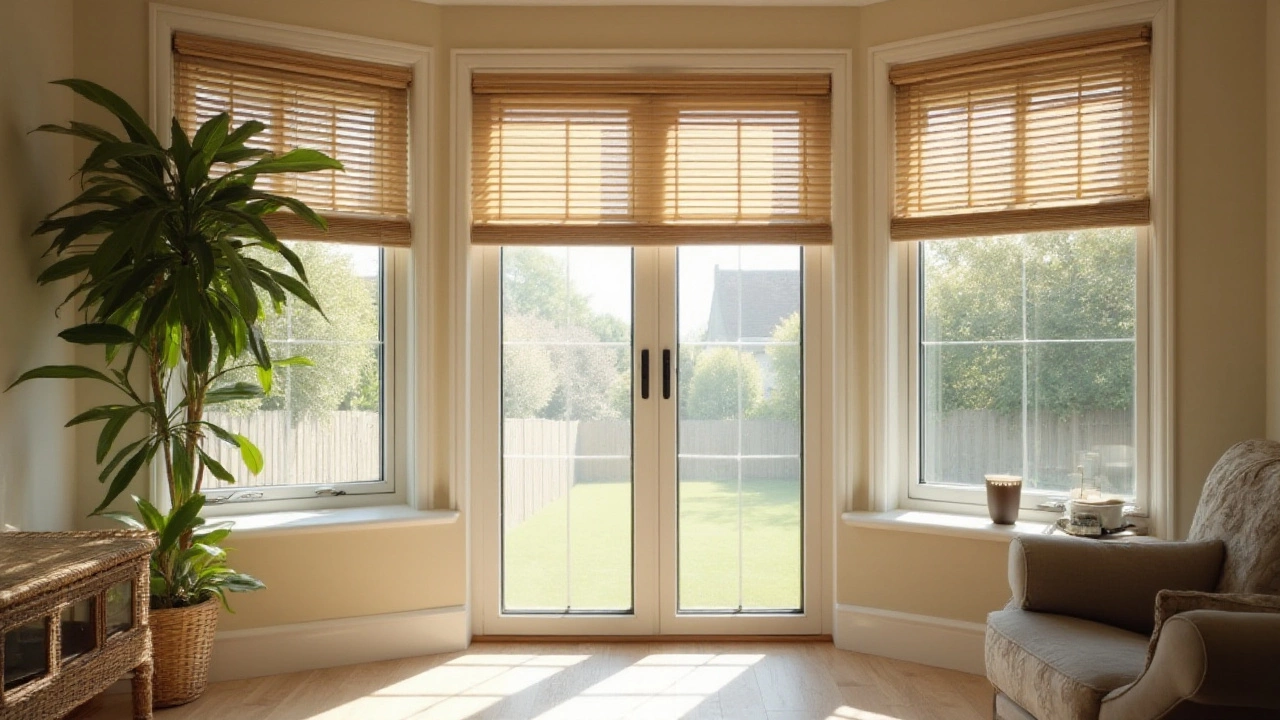Windows are the eyes of our homes, inviting in light and framing our views of the world. While curtains have long been the go-to dressing for windows, they are not always the primary solution. There are many reasons why one might choose to leave windows uncovered or explore other options.
Whether it's the pursuit of more natural light or the importance of maintaining a modern and minimalist aesthetic, going curtain-free can be both refreshing and functional. Some spaces simply thrive without the traditional fabric frame.
This article examines when you might reconsider curtains altogether, delving into various scenarios where alternatives might serve a space better. You'll find guidance on achieving the right balance between light, privacy, and style, offering fresh perspectives for a revitalized home environment.
- Maximizing Natural Light
- Emphasizing Modern Aesthetics
- Low-Maintenance Living
- Limiting Allergen Accumulation
- Creative Privacy Solutions
Maximizing Natural Light
Optimizing the flow of natural light into a home can dramatically transform a space, creating a sense of openness and vitality. When we talk about maximizing natural light, it is not just about opening the windows wide and hoping for the best. Instead, it involves thoughtful design choices that work harmoniously with your room's architecture. Without curtains, windows can act as a direct portal for the sun's rays, ensuring that every corner of the room is well-lit. Not having curtains can encourage more full-spectrum daylight to enter, benefiting not only the aesthetic quality of your home but also its environmental cost and your well-being.
Strategically allowing sunlight to penetrate your home can also reduce the need for artificial lighting during the day, positively impacting energy consumption. Studies reveal that exposure to natural light improves mood and productivity, making spaces more functional for work and relaxation. As people spend more time indoors, particularly in urban settings, harnessing sunlight smartly becomes even more important. The use of mirror placement and light-colored walls can amplify the effect, bouncing natural light further into your interior. A 2018 report from the National Renewable Energy Laboratory (NREL) emphasized that optimizing daylight penetration could reduce electrical lighting demand in office spaces by up to 60%.
Consider different ways to utilize window space without curtains. Clean, large panelled windows or picture windows without interruptions draw the outdoors in. This design approach promotes an uninterrupted view that is especially spectacular if your home is surrounded by nature. Including skylights or glass doors, such as sliding or bi-fold, is another method to welcome additional daylight. According to architect John Pawson, "Light is a powerful substance. We have a primal connection to it. But, for something so seemingly simple, it holds great mysteries."
"Lighting can transform space substantially, affecting mood and our perception."Therefore, thoughtful design that maximizes illumination becomes not just a stylistic choice, but a deeply functional one.
While soaking up all that glorious daylight, it is also crucial to consider window placement and glazing choices to avoid heat gain, which can lead to discomfort, especially during summer months. Low-emission (Low-E) glass and thermal coatings are innovative solutions that help maintain a pleasant indoor temperature without sacrificing the benefits of natural light. Moreover, strategically placed awnings or pergolas can shade windows, reducing glare while allowing a consistent stream of softer light. When envisioning a curtain-free space, one should remember that natural light is not only a visual enhancer, but also a valuable component of sustainable living. By merging ecological sensibility with clever design, your windows can become a true asset to the natural ambience of your home.
Emphasizing Modern Aesthetics
In the realm of contemporary design, embracing a clean and minimalist approach can transform a living space. When it comes to enhancing modern aesthetics, the decision to forego curtains might be a pivotal choice. Modern design often celebrates simplicity, focusing on clean lines, open spaces, and the strategic use of materials and colors. Curtain alternatives such as sheer paneling, frosted glass, or even window films can maintain these principles while adding a sleek touch to any room. Blinds with a streamlined design or shades that tuck neatly away when not in use, also reflect a commitment to uncluttered beauty.
The idea of modern aesthetics hinges on creating an environment that is both functional and visually appealing. This often means that elaborate fabrics or heavy drapery, hallmarks of more traditional design styles, might be left behind in favor of options that complement rather than compete with the structural elements of a space. You might find that removing curtains altogether unveils architectural details that serve as stunning focal points. Interestingly, modern architects have frequently noted that natural light is used as a tool to enhance a space's character. Celebrating natural light by opting for large unobstructed windows can not only enhance the style but also improve the mood and energy efficiency of a home.
Consider how renowned architects, like Le Corbusier, emphasized open spaces and light, famously noting, "The history of architecture is the history of the struggle for light." By allowing windows to spill light unimpeded across interiors, a room can feel more spacious, with boundaries becoming beautifully blurred. This clarity provides a harmonious continuity from indoor to outdoor spaces, another signature of modern design. It is a wonderful way to unite the internal living areas with the surrounding landscape and extend the living space beyond traditional confines.
Furniture and decor further contribute to the serene, uncluttered look of modern homes. Without curtains, selecting pieces that harmonize with your window treatments becomes vital. Choose sleek, minimalistic pieces that echo the lightness and simplicity emphasized by curtain alternatives. Materials such as metals, glass, and smooth woods can contribute to a cohesive design. Adding a few select pieces of art or decor can draw attention to the natural interplay of light and shadow, creating dynamic and inviting spaces.
For those concerned with privacy, there are numerous solutions that cater to modern tastes. Window treatments like smart glass, which can turn opaque at the touch of a button, offer a high-tech alternative to traditional curtains without sacrificing the minimalist aesthetic. Shades crafted from natural, sustainable materials can provide privacy while fitting seamlessly into the modern design ethos. For spaces needing a bit more privacy during the evening hours, consider innovative solutions like motorized blinds or dual-function blinds which offer versatility without overwhelming a room's style.

Low-Maintenance Living
In the bustling rhythm of modern life, many are seeking simplicity and ease wherever possible. This quest extends right into our living spaces, where the goal is often to reduce clutter and upkeep demands. Opting for curtain alternatives can be a smart move to minimize daily chores, especially if you're someone who cherishes a low-maintenance lifestyle. Curtains, beautiful as they may be, tend to require regular washing and dusting. In fact, they can become magnets for dust and allergens, particularly in urban environments like London, where air quality can fluctuate significantly.
Without the need for fabric maintenance, you save time and effort, shifting focus onto more fulfilling activities. One popular alternative is the use of blinds, which generally need less frequent cleaning compared to curtains. Materials like faux wood, metal, or even vinyl lend themselves well to a simple wipe-down, unlike fabric curtains that necessitate washing and rehanging. Investing in high-quality blinds can also result in long-lasting window treatments, saving on replacement costs down the line.
"Minimalism is not a lack of something. It’s simply the perfect amount of something." – Nicholas Burroughs
If blinds don't resonate with your style, consider shutters. Not only are they elegant, often oozing a timeless charm, but they also offer practical benefits. Shutters are inherently robust, generally feature adjustable slats to control light entry, and can be molded to fit any window shape. To add a warm touch to your living space without curtains, think about window film options. These films can obscure the view from outside while allowing natural light to pour in uninhibited.
For those who cherish a unique twist, frosted glass might be an intriguing option. This design choice provides both privacy and a modern aesthetic, though it necessitates a bit of planning during home renovations. Essentially, the choice to bypass curtains can enhance the simplicity of home maintenance, freeing up time previously occupied with upkeep. For anyone embracing interior design with functionality, considering alternatives offers a brilliant path to low-maintenance living, merging style with practicality seamlessly.
Limiting Allergen Accumulation
For those who suffer from allergies, the choice of window dressings can be crucial. Curtains, especially heavy or layered ones, can become a hotspot for dust mites, pollen, and other allergens. Over time, these particles can accumulate without regular cleaning, leading to a plethora of allergy symptoms. While some might clean their curtains frequently, the task can be quite cumbersome and easily overlooked. In contrast, opting for window treatments that naturally resist allergen buildup is a practical solution.
Among the recommended alternatives are blinds and shutters. These options tend to gather less dust and, importantly, are easier to clean. A simple wipe down can remove accumulated particles, making them an ideal choice for allergy-prone households. Moreover, materials like vinyl and aluminum used in many blinds don’t provide the textile environment that dust mites thrive in, unlike traditional fabric curtains. This ensures a cleaner, allergen-reduced home environment, contributing to the overall health and comfort of the residents. No curtains also promote improved airflow through the windows, which can further help disperse any lingering particles that might be floating in the air.
As Dr. Emily Stanton, a prominent allergist, pointed out:
"It's all about minimizing the areas where dust can settle and mites can thrive. In an allergen-sensitive home, every choice—from flooring to window treatments—plays a role in managing symptoms."With Dr. Stanton's advice in mind, it's worth considering that smooth surfaces, whether vertical or horizontal, reduce the opportunities for allergen build-up. Some households are also embracing retractable screens or UV-blocking window films as alternatives, which serve similar purposes without introducing fabric-related challenges.
Another option that complements the idea of limiting allergens is the use of air-purifying houseplants near windows. Though they can’t replace the need for regular cleaning, plants such as the peace lily and snake plant absorb airborne toxins, adding a layer of defense against allergens. By choosing window treatments wisely, those suffering from allergies can significantly enhance their quality of life at home, making it a place of true comfort and relaxation.

Creative Privacy Solutions
When considering curtain alternatives, it’s important to think about privacy while maintaining the beauty and functionality of your space. Traditional curtains can block essential light or overwhelm a room with their bulk, leading homeowners to seek innovative solutions that offer privacy without sacrificing aesthetics. For those who appreciate an airy and open atmosphere, there are several approaches to ensure privacy effectively while keeping the interior inviting and light-filled.
One popular method is to employ window films. These are versatile, adhesive layers that can be applied directly to the glass. They come in patterns and designs, capable of mimicking frosted glass or even stained glass effects, providing privacy without the weight of fabric. These films allow natural light to flood the room while obscuring the view from the outside. An advantage of this option is its flexibility; you can easily change the films to match seasonal decor or personal taste. Noted designer, Jonathan Adler, once said, "The perception of personal space can be compromised without the right solutions, and window films provide that perfect balance between openness and seclusion."
Sliding panels, often used in modern spaces, are another stylish curtain alternative. These panels can be crafted from various materials such as bamboo, fabric, or even rice paper, offering an elegant Japanese-inspired look. They provide substantial coverage and are ideal in bedrooms or living areas facing high-traffic zones. The flexibility to slide them entirely away means you can enjoy unobstructed views when privacy is not a concern. Additionally, sliding panels work exceptionally well in large window areas and can be custom-designed to fit any home’s unique architecture. Their multifunctionality also allows them to serve as room dividers when the need arises.
Living walls and strategic plant placement are eco-friendly solutions gaining momentum. Interior greenery not only enhances the ambiance, making a room appear lively and fresh, but it can also act as a natural privacy barrier. Tall potted plants or vertical gardens near windows can shield interiors from prying eyes while creating a serene atmosphere. This approach is particularly beneficial for ground-floor spaces facing city streets. Succulents, ferns, or even bonsai trees can be arranged in patterns to diffuse light effectively and provide an organic touch to your interiors.
Another option gaining popularity is the utilization of layered shades. These shades allow for diffused lighting while maintaining privacy. They are crafted from woven woods or treated fabrics that offer various levels of opacity. Layering shades can achieve a look that’s both modern and classic, fitting well with numerous design styles from bohemian to contemporary. This approach provides an interesting blend of light control and privacy management in spaces where flexibility is paramount. Shades can be easily adjusted for different times of the day, accommodating changes in light requirements and privacy needs throughout the day.
High-tech solutions are also emerging, with smart glass being at the forefront. This innovative technology allows for the transition of glass from transparent to opaque at the flick of a switch, offering unparalleled convenience for modern homeowners. Although pricier, smart glass gives absolute control over privacy and light at any given time, proving its worth in both residential and commercial spaces. As smart home technology advances, such solutions are becoming more accessible and popular for homeowners eager to invest in the future of interior design.
